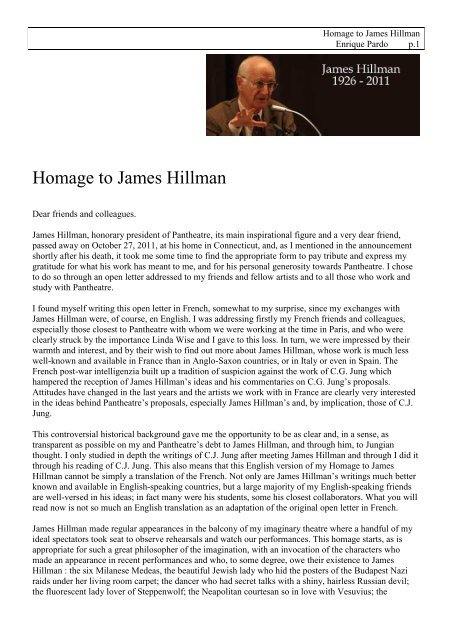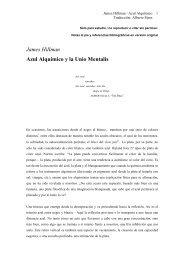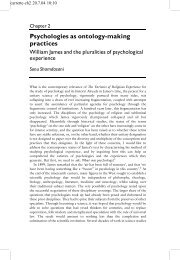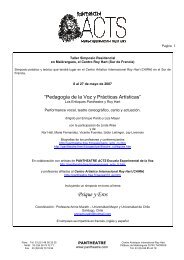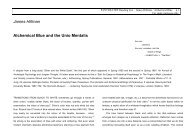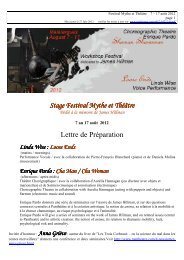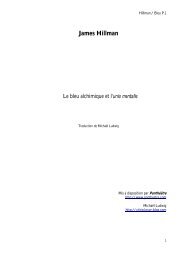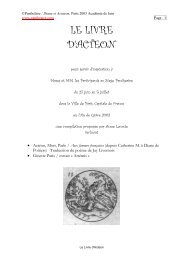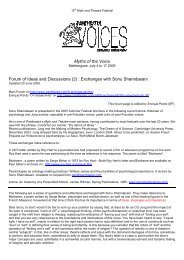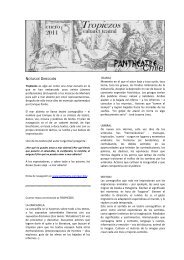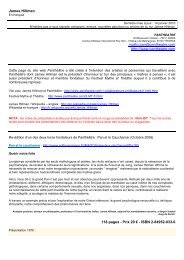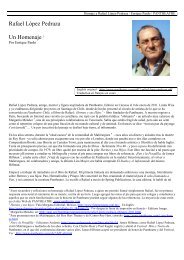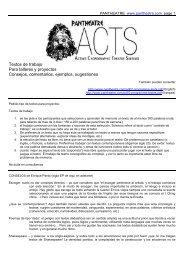1-james-hillman-homa.. - Pantheatre
1-james-hillman-homa.. - Pantheatre
1-james-hillman-homa.. - Pantheatre
Create successful ePaper yourself
Turn your PDF publications into a flip-book with our unique Google optimized e-Paper software.
Homage to James Hillman<br />
Dear friends and colleagues.<br />
Homage to James Hillman<br />
Enrique Pardo p.1<br />
James Hillman, honorary president of <strong>Pantheatre</strong>, its main inspirational figure and a very dear friend,<br />
passed away on October 27, 2011, at his home in Connecticut, and, as I mentioned in the announcement<br />
shortly after his death, it took me some time to find the appropriate form to pay tribute and express my<br />
gratitude for what his work has meant to me, and for his personal generosity towards <strong>Pantheatre</strong>. I chose<br />
to do so through an open letter addressed to my friends and fellow artists and to all those who work and<br />
study with <strong>Pantheatre</strong>.<br />
I found myself writing this open letter in French, somewhat to my surprise, since my exchanges with<br />
James Hillman were, of course, en English. I was addressing firstly my French friends and colleagues,<br />
especially those closest to <strong>Pantheatre</strong> with whom we were working at the time in Paris, and who were<br />
clearly struck by the importance Linda Wise and I gave to this loss. In turn, we were impressed by their<br />
warmth and interest, and by their wish to find out more about James Hillman, whose work is much less<br />
well-known and available in France than in Anglo-Saxon countries, or in Italy or even in Spain. The<br />
French post-war intelligenzia built up a tradition of suspicion against the work of C.G. Jung which<br />
hampered the reception of James Hillman’s ideas and his commentaries on C.G. Jung’s proposals.<br />
Attitudes have changed in the last years and the artists we work with in France are clearly very interested<br />
in the ideas behind <strong>Pantheatre</strong>’s proposals, especially James Hillman’s and, by implication, those of C.J.<br />
Jung.<br />
This controversial historical background gave me the opportunity to be as clear and, in a sense, as<br />
transparent as possible on my and <strong>Pantheatre</strong>’s debt to James Hillman, and through him, to Jungian<br />
thought. I only studied in depth the writings of C.J. Jung after meeting James Hillman and through I did it<br />
through his reading of C.J. Jung. This also means that this English version of my Homage to James<br />
Hillman cannot be simply a translation of the French. Not only are James Hillman’s writings much better<br />
known and available in English-speaking countries, but a large majority of my English-speaking friends<br />
are well-versed in his ideas; in fact many were his students, some his closest collaborators. What you will<br />
read now is not so much an English translation as an adaptation of the original open letter in French.<br />
James Hillman made regular appearances in the balcony of my imaginary theatre where a handful of my<br />
ideal spectators took seat to observe rehearsals and watch our performances. This <strong>homa</strong>ge starts, as is<br />
appropriate for such a great philosopher of the imagination, with an invocation of the characters who<br />
made an appearance in recent performances and who, to some degree, owe their existence to James<br />
Hillman : the six Milanese Medeas, the beautiful Jewish lady who hid the posters of the Budapest Nazi<br />
raids under her living room carpet; the dancer who had secret talks with a shiny, hairless Russian devil;<br />
the fluorescent lady lover of Steppenwolf; the Neapolitan courtesan so in love with Vesuvius; the
Homage to James Hillman<br />
Enrique Pardo p.2<br />
alcoholic clown who started aggressing children – and their mothers; the feminist siren; the nine worthy<br />
women; Marsyas, singing all-out rock and roll; Bluebeard’s Pulcinella mad wife; Marie-Antoinette, the<br />
immigrant queen and her Pierrot pianist; the Beirut widow visiting her husband’s tomb in Hecate’s<br />
graveyard; the little witch who gleefully sings out of tune; the American brat who followed Ronald<br />
Reagan in his Alzheimer’s descent to hell 1 .<br />
The artists who performed these figures were naturally prominent among those who asked me the two<br />
questions I answer in this Homage to James Hillman:<br />
Why was his work so important to me?<br />
How to approach it - especially from <strong>Pantheatre</strong>’s the point of view?<br />
This is therefore also an act of transmission: the intended letter has become an article of some fifteen<br />
pages where I present the major landmarks of James Hillman’s work, how I came upon it, the key impact<br />
points it had on my artistic and philosophical journey, and, of course, on <strong>Pantheatre</strong>’s training and<br />
creation processes. This letter is also "open" in that I will continue to complete it, especially the footnote<br />
references and Internet links 2 .<br />
James Hillman was, as I mentioned above, particularly generous with <strong>Pantheatre</strong>; the word that comes to<br />
mind is the Greek notion of charis and two qualities that derive from it, which James Hillman brought<br />
remarkably together: charisma and caritas - qualities that reflected his capacity to exercise his<br />
exceptional intelligence with grandeur d’âme, soul magnanimity, i.e. kindness of heart. He himself<br />
defined the spirit of heartful charis in one of his keynote lectures at the Eranos conferences: The Thought<br />
of the Heart (1979). Contemporary theatre performances still resound with the echoes of Antonin<br />
Artaud’s desperate screams and of what he termed theatre of cruelty and we cannot bypass the schism<br />
they create: the mix of revolutionary love for humanity and the terrible, mad, dark realisations, as well as<br />
the ritual and imagistic forms of theatre he dreamed of. James Hillman offered one of the most insightfull<br />
and balanced models that confront the figures that move in the shadows of cruelty. He had an<br />
exceptionally poised attitude and sense of consideration for everything that presented itself to his gaze, a<br />
gaze of rare sagacity: a quality of attention and humanity he had no doubt honed during his years as an<br />
analyst.<br />
During a visit in May 2011 to the Manhattan loft where he and his wife, Margot, stayed - he was already<br />
seriously ill - he asked me what aspects of his work had interested me so much. His question took me by<br />
surprise: the answer seemed so obvious to me. I realized we had known each other for over thirty years -<br />
and that during those thirty years he had written over a dozen books and addressed an impressive array of<br />
topics and audiences. For my part, I had taken his ideas on board, so to speak, as I had encountered them<br />
in the early eighties, and had used them as inspiration in all kinds of artistic enterprises. And so I<br />
answered his Manhattan question with a list of words: imagination, image-making, anima, psyche, the<br />
dramaturgy of dreams, his reflections on narration... My list could have been a long one. I left out, for<br />
instance, his reflections on emotion, which had been the title of the 2010 Myth and Theatre Festival, and<br />
the theme of his doctoral dissertation in 1960! 3<br />
1 Video presentations of these performances are on http://www.pantheatre.com/8-videos.html<br />
2 Contributions are welcome, especially in order to complete the references to French translations, presented on<br />
http://www.pantheatre.com/pdf/1- James <strong>hillman</strong>.pdf. Also, I often quote authors or artists without giving references because<br />
today we have available Internet search engines to learn about their bibliographies.<br />
3 Emotion: a comprehensive phenomenology of theories and their meanings for therapy, 1960. The Myth and Theatre Festival<br />
(created in 1987) is presented on : http://www.pantheatre.com/gb/2-MT-gb.html
Homage to James Hillman<br />
Enrique Pardo p.3<br />
In 1979 I first wrote to James Hillman to ask for permission to quote from his book Pan and the<br />
Nightmare in a performance I was devising: Calling for Pan. Initial contacts were with him, with Rafael<br />
Lopez-Pedraza 4 and with Professor Charles Boer. All three visited Malérargues soon after. At the time<br />
Malérargues was the home of a rather disoriented and isolated community of artists, deep in the Cevennes<br />
Southern France countryside. Years of exchanges and friendship followed. One reason for the perdurance<br />
of these exchanges was the importance James Hillman gave to imagination, to fiction and to the artistic<br />
process in psychotherapy. It was one of his main differences with the clinical tendencies in<br />
psychotherapy, even among the Jungian community. It must be pointed out that he was an exceptional<br />
writer - one of the greatest artists of thought and of its expression I have known.<br />
In the summer of 1980 I literally locked myself up with his book: The Dream and the Underworld. It was<br />
during a holiday in Corsica and I had to be dragged away from it to the beach! I was astounded by the<br />
mindscape James Hillman presented on the nature and function of dreams. For an artist whose horizon<br />
had been fundamentally one of baroque aesthetics – especially in its oniric dimensions - I found a cultural<br />
world-view I immediately recognized as the one I had been searching for, and to which I clearly felt I<br />
belonged. I also discovered the cultural work I had to do in order to catch up and, as it were, actually<br />
make myself at home. All of the references and associations I had looked for during my Fine Arts and Art<br />
History studies were there, and many more, supporting a psychological and mythological vision of the<br />
imagination of astonishing cultural dimensions and wealth. For someone who had chosen theatre as his<br />
means of artistic expression, this book was a magical manual!<br />
Following are some examples of working themes that are directly related to the intellectual horizon James<br />
Hillman presents in this book - themes that those of you who have worked with me on choreographic<br />
theatre will recognize straight away.<br />
o The shift away from a subjective, psychologically realistic theatre, towards one in which we<br />
contemplate the dream and not (necessarily) the dreamer.<br />
o The status of the ego – what James Hillman also calls “the imaginal ego” - in a choreographic<br />
theatre landscape and the philosophy of priorities between subject, object, project.<br />
o The notion of antagonism and the dramaturgical strategies used to ‘set-up’ the protagonist in order<br />
to actually free him/her - and the text - from authorial versions and protagonistic responsibilities.<br />
o How to lure and subvert the dramatic ‘missionary’ role of the actor-hero-herald. How to turn his<br />
or her ‘mission’ upside down, and create a different ‘under-standing’ – what we call the “submission”<br />
within a post-tragic theatre.<br />
o Fundamentally: how to define the mythological geography of the stage itself. The term<br />
“underworld” refers to the pagan hells, the kingdom of Hades and of the dead – the ultimate<br />
metaphorical, and in a sense, ‘theatrical’ realm.<br />
o The conception of the stage and of its choreographic networks as context, through which the<br />
interpretation of the texts (and of dreams?) takes place – an ‘imaginal’ procedure which has led to<br />
our current working motto: “if you find your place you will find your voice”.<br />
James Hillman’s book gave me the foundations for a theatrical hermeneutics. But, having stated this, The<br />
Dream and the Underworld is only one of the four books which I consider to be the pillars of his work 5 . I<br />
could cite as many references and working links to <strong>Pantheatre</strong> from each of the three other books, not to<br />
4 Rafael Lopez-Pedraza passed away in January 2011. See our <strong>homa</strong>ge on http://www.pantheatre.com/pdf/1-rafael-lopez-pedraza.pdf .<br />
5 The four books I consider to be the pillars of James Hillman’s work, written in the 70s and 80s are :<br />
Re-visioning Psychology – 1975.<br />
The Dream and the Underworld - 1979<br />
The Myth of Analysis – 1983<br />
Healing Fictions - 1983
Homage to James Hillman<br />
Enrique Pardo p.4<br />
mention those he wrote before and after The Dream and the Underworld, or his many lectures, including<br />
the magisterial ones he delivered at the Eranos conferences in Ascona, Switzerland.<br />
An important note here: James Hillman was the founding figure of what he titled archetypal psychology.<br />
He also used at times the title of imaginal psychology, by affinity with the thought of Henri Corbin, the<br />
French philosopher, specialist of Iranian Sufism and Shiite gnosis, whom he met at Eranos. James<br />
Hillman was director of studies at the Jung Institute in Zurich until 1975, and the fact that he named his<br />
work “archetypal psychology” emphasizes the founding importance he gave to the concept of archetype<br />
in the work of C.G. Jung. I make this aside because today the concept of archetype has become allpervading;<br />
it has passed into everyday language and especially into pop-psychology where anything of<br />
importance tends to become “archetypal”... It is in fact a demanding cultural notion which belongs to the<br />
predominance in the first half of the 20th century of comparative thinking – especially in the area of<br />
comparative religious studies, an important historical moment which is not necessarily my intellectual<br />
landscape. Rather than speaking of archetypes I prefer to take my courage in both hands and speak<br />
directly of the gods and goddesses, that is, of the “figured-out” archetypes, either the nucleic images from<br />
which the archetypes are abstracted, or, inversely, the archetypes as the emotional nebulae out of which<br />
the imaged gods emerged - were “invented.” James Hillman has also spoken of “mythological<br />
psychology” and of “alchemical psychology” to mark his preference for a figurative and metaphorically<br />
differentiated approach to theology 6 , one that invites the anecdotic idiosyncrasy implied by the notion of<br />
image: something that is central to his philosophy of the imagination. He thereby distinguishes his<br />
approach from symbolic, linguistic, structural and generally more abstract forms of thinking.<br />
Many of you know the story of the exchanges between <strong>Pantheatre</strong> and James Hillman. They are<br />
documented on the site www.pantheatre.com and we will be adding further archive material. Some of you<br />
met him in theatre laboratories, heard him lecture or harangue, sometimes fiercely, the participants. He<br />
trained us in imaginal criticism, in what he described as “seeing through”: sharpening the psychological<br />
and metaphorical gaze that can “see through” the opacity and inevitable opinionations of any artistic<br />
creation or of any dream for that matter, in order to ‘figure out’ the archetypal undercurrents, the driving<br />
figures (divinities) and their narrative argumentations (myths). James Hillman turned mainly to the<br />
Mediterranean deities of the Greco-roman pantheon and to the often subterranean trail of paganism in<br />
Western psyche and art, leading to its great “re-birth” during the Italian Renaissance. The city of Florence<br />
actually honoured James Hillman for his work on the Renaissance. In many ways James Hillman,<br />
American, of Jewish origin, trained in Zurich with C.G. Jung, became a Florentine aristocrat.<br />
As the heart of this <strong>homa</strong>ge I wish to address what I consider to be the most influential figure in James<br />
Hillman’s mindscape, a figure he elucidates and elaborates by gathering and organizing the intuitive<br />
flashes of insight scattered throughout the work of C.G. Jung. It is the figure of anima. He does this<br />
principally in his book: Anima: An Anatomy of a Personified Notion, 1985, where he displays all the<br />
finesse of his analytical mind, of his mytho-poetic tact - his exceptional ability to recognize and think<br />
image – and to place himself at the psychic interface where ideas, images and emotions meet – the locus<br />
imaginalis where figuration crystallizes.<br />
In many ways the mythological figure of anima emerges after that of Psyche, who is herself a late-comer<br />
in Mediterranean mythology: Psyche makes her main appearance with Apuleius in the 2nd century AD<br />
under terrible hardship due to the relentless, and sometimes homicidal opposition of Aphrodite. The<br />
notion and the history of anima are later still and less easily located. James Hillman summons her to<br />
figure out, reflect and organize the phenomenology of that locus we call imagination - the “image<br />
factory”. I consider the “anatomical” dialogues James Hillman establishes with the notion of anima as<br />
exemplary and essential for those of us who work, precisely, in a locus imaginalis called theatre: the stage<br />
6 A special mention here of the theological dialogues between James Hillman and David Miller whose book Christs inspired<br />
one of <strong>Pantheatre</strong>’s early performance titled Poesis with poems by Wallace Stevens.
Homage to James Hillman<br />
Enrique Pardo p.5<br />
as the place for metamorphosis, where ideas are transformed into images, where images give body to<br />
ideas - a meeting place between text and context, between speech and emotion, between voice, gesture<br />
and music. One of the crucial tasks that James Hillman undertakes is to differentiate the personifications<br />
of Anima, Psyche and Aphrodite, and of their corollaries, their dominant “moods” landscapes (in French:<br />
états d’âme - states of soul, of anima): beauty, eroticism, consciousness, spirituality, sentimentality,<br />
seduction, melancholy, animosities, opinions... The figure of anima is particularly busy in these<br />
‘moodscapes’, along with what is considered to be her male counterpart, the notion of animus. I will<br />
come back to this gendered duality, and address as well the predominance of feminine figures in such a<br />
mythological census 7 .<br />
I wish to make it clear at this junction that these are my conclusive priorities, which apply first and<br />
foremost to an artistic “methodology.” I do not claim to know if James Hillman would have agreed with<br />
my point of view and choice of priorities in his work. My committed stand is the following: the notion of<br />
anima refers to the mythical figure, "the personified notion" in terms of the cultural and neurobiological<br />
factor that calls up and filters emotionally the primary choices of imagination. Anima fashions and<br />
colours both the morphology and the thinking bias of images, i.e. the compelling trends, the “character”<br />
of the psyche, of Psyche. It is mainly under anima influence that the figures which inhabit our passionate<br />
substrates arise and take shape, the figures that rule for instance our thinking or our ideologies. I give this<br />
“anatomical” description of the notion and of the dynamics of anima by analogy to the artistic process,<br />
and particularly in the context of live-performances, the physical and emotional ambit in which images<br />
rise and organize themselves.<br />
I hope it is becoming clear why I give such importance to James Hillman’s anima mode of reflecting – a<br />
mode of thinking about thinking which stays as close as possible to the emotional “live” impact of the<br />
performance-dream, following in the steps of C.J. Jung’s advice to “stick to the image” and not to move<br />
to interpretations too soon. James Hillman describes his essay on anima as the “anatomy of a personified<br />
notion”. Calling upon the notion of “anatomy” brings soma into the picture, which is especially relevant<br />
to what we call “giving body to fiction”: acting out and performance as realization (“do you realize what<br />
you are doing?”) - i.e. the expressive anatomy of acting.<br />
The move to “personify” a notion alludes to a process James Hillman posits as essential to mythical<br />
image-making: the process of personification 8 . This process is central to choreographic theatre; I tend to<br />
speak especially of “figuring out”, which includes, of course, fictional figures like those mentioned at the<br />
beginning of this <strong>homa</strong>ge. Anima is the mediating factor/figure through whom we can “figure out” what<br />
drives our choices: the roots of our emotional urgencies, the relational qualities of our moves, their tact<br />
and (imp)pertinence 9 , the cultural relativity and psychological awareness of a performance. Anima<br />
perception is what I place at the heart of artistic practice and criticism. Psyche makes the choices under<br />
anima influence - I will return to this below. There is, moreover, a great cultural pleasure, a "fabulous<br />
7 The anima / animus duality is a ‘classic’ Jungian theory, psychologically brilliant and founded on rich speculative traditions,<br />
but, like many junguians concepts, it has to some extent been intellectually diluted by its very popularity. I should mention<br />
here the impressive use French writer Anna Grieve makes of it in her recent book: Les Trois corbeaux, ou la science du mal<br />
dans les contes merveilleux (Editions Imago, 2010). The Three Ravens, or the science of evil in fairy tales – not yet translated<br />
into English. See: http://www.pantheatre.com/gb/2-LE11-gb.html<br />
8 James Hillman describes two basic operations of mythic imagination: personification and pathologizing - the latter being one<br />
of the principal enterprises in his "re-visioning" of psychology. The aim is not so much to cure, or to interpret, but to seize the<br />
dynamics of imagination – its imagines agentes (its active-acting images.) He does this particularly in his Re-Visioning<br />
Psychology.<br />
9 I have always been struck by the use of “play” in theatre. In English it is linked mainly with plot construction. In French, with<br />
the fact of acting itself (“le jeu de l’acteur”). My definition of improvisation is: “imps at work”: an impulse is a shove by an<br />
imp. It casts a playful light on “imp” words like “impossible”, “impressive”, and many others – but it also beckons us into<br />
tricky militant psychology territories – well beyond impish ludicity. Currently the question I ask is: “Are you vodou or are you<br />
dada? Or are you just haha?” See www.pantheatre.com/gb/2-Sy12-gb.html
Homage to James Hillman<br />
Enrique Pardo p.6<br />
sensuality" in the use of such a model of perception-thinking, which is what James Hillman calls<br />
aesthetics.<br />
There are two other important persons, a philosopher and an artist, whose work and proposals can be<br />
linked to an “anatomical” approach to anima, and whose corporal/poetical visions many of us have<br />
studied and even followed; both turn to the notion of voice as a root metaphor. I refer firstly to Roy<br />
Hart 10 , whose philosophy and practice of the voice made a literal bridge to anatomy: the practice of<br />
singing was for him the “anatomical” principle of, precisely, animation. To a great degree his very life<br />
was a working dialogue between voice and anima. One of his favourite quotes was: “the voice is the<br />
muscle of the soul” – of special relevance here, since “soul” and anima have direct semantic kinships.<br />
The other reference is Jacques Derrida and his use of the notion of voice. He does not, as far as I know,<br />
refer to the figure of anima; he did invent the neologism animot, soul-word, and homonym of animaux,<br />
animals. The Italian philosopher Giorgio Agamben has given an indirect definition that I appreciate<br />
particularly: “Listening to the voice in speech is what thinking is all about”. A considerable number of<br />
parallels have been made in recent years between James Hillman’s model of thought and Jacques<br />
Derrida’s, related mainly to their methodologies, comparing especially James Hillman’s seeing through<br />
with Jacques Derrida’s deconstruction. James Hillman clearly resisted the comparisons; although he had a<br />
special affection for France - he studied at the Sorbonne at the time of existentialist Saint Germain des<br />
Près – but he distrusted thoroughly what he called the French Cartesian "bug". I mention Roy Hart and<br />
Jacques Derrida by poietic analogy because both, as does James Hillman, take us to a figured territory<br />
that straddles logical philosophy and poetic speculation - an area too complex to call only on an<br />
“anatomy” that is formal, rational, linguistic, structural or even psychoanalytic.<br />
Through the mythology of anima James Hillman has given us the tools to reflect on two other principles,<br />
two phenomenologies crucial to the artistic ethos of my generation, and thus to what <strong>Pantheatre</strong> proposes:<br />
the notions of femininity and of shamanism. The quest for femininity was one of the great crusades of the<br />
60s and 70s - pre-feminist. It was a revolutionary upsurge, both political and artistic, with a strong dose of<br />
anarchistic rage - but it was definitely ‘testosterone’ dominated. The figure of anima is, of course,<br />
eminently feminine. Its mythology re-emerges and takes shape in the late Middle Ages, especially with<br />
the figures of Beatrice in Dante and of Laura in Petrarch. This is the woman-figure who appears in the<br />
ivory tower of courtly love. She becomes an artistic soror in the Renaissance, the muse of Romanticism.<br />
Nevertheless, in this scheme, the poet remains a man: the woman-figure stays sublimated in the balcony<br />
of inspiration. James Hillman’s reflections on the mythology of anima are contemporary with the colossal<br />
repositioning that feminism had to operate in order to confront the patriarchal patterns of our societies. I<br />
wish to underline the “mythological” take on these historical facts because they belong to a territory<br />
where the “anatomic” behaviour of anima can become terribly passionate, especially if faced with<br />
gendered identification : anima can enter violently rebellious moods when she identifies with the<br />
historical status of women, a violence stemming from her need to differentiate between myth and reality,<br />
a need to redefine the relationships between mythology, gender identity and socio-political reality. The<br />
title of a recent book by Giulia Sissa comes to mind: L’Âme est un corps de femme (The Soul is a<br />
Woman's Body) 11 . When there is comparative gender opposition, anima can turn into animosity.<br />
The necessity to confront and think the tensions between anima and femininity and to differentiate their<br />
mythological dynamics, I consider to be possibly the most complex and challenging factor in artistic<br />
criticism today. The subject itself of a performance does not have to do literally with anima and woman,<br />
or with man / woman relationships. Anima reveals the emotional tone and hence the qualitative values in<br />
the choices and in the treatment of a subject, the affective tone and the passions of logos as it faces and<br />
10 For those who are not acquainted with the work of Roy Hart, see http://www.pantheatre.com/gb/1-roy-hart-gb.html<br />
11 Giulia Sissa has published another a remarkable book on these subjects : Sex and Sensuality in the Ancient World, 2008.
Homage to James Hillman<br />
Enrique Pardo p.7<br />
comments images. Anima is the emotional body moving (animating) cultural biases: I place awareness of<br />
anima at the heart of artistic intelligence. To sense and think in terms of anima allows us not only to<br />
“figure out” our erotic choices - a ‘performative’ area where we expect anima to be influential - but also<br />
the emotional, or call them “archetypal”, configurations behind political or ideological discourses. Such<br />
critical connections between art, politics and eroticism establish a psychological and cultural<br />
interdependence of exceptional richness; these are the scores James Hillman played and commented with<br />
virtuoso touch. To tackle such scores one needs great tact, whether the artistic move is made in sensual<br />
veneration or in aggressive iconoclasm. It requires ethical consciousness and cultural know-how, so as<br />
not to fall into anima shortcuts, valuable as they can be, such as: "tell me who you desire and I will tell<br />
you what your thinking is worth", or into the use of reductive oppositional thinking between male and<br />
female. One has to move way beyond “anima is the woman in man.” Elaborate anima-thinking asks for<br />
cultural relativity, intellectual complexity, critical compassion (grandeur d’âme.) This was the legacy<br />
James Hillman left us.<br />
I turn now to the second “phenomenology”: the attraction the shamanic model excerts on contemporary<br />
performance art 12 . In an exchange last year with James Hillman I expressed how struck I had been during<br />
a visit to Salvador de Bahia, in Brazil, to see dancers and actors we were working with us, involved in<br />
Candomblé rituals and practising trance figurations of their pantheon’s deities. James Hillman guessed<br />
my thoughts; he said: “It takes shamanistic moves to sidestep the control of the Western rational mind”,<br />
and he added something like: “Good luck to you, artists!” This remark and the tone in which he made it<br />
contain the kernel of why this <strong>homa</strong>ge is centred on his understanding of anima. James Hillman provides<br />
a frame for our cultural fascination towards the shamanic model which involves highly intuitive actingout<br />
with often risky social and political implications, proposals that seem to stem from personal reactions:<br />
ethical-anatomical (the famous: “I feel it in my body”), leading often to disconcerting, provocative<br />
initiatives that seek the “medicinal” in art 13 . James Hillman said something I consider crucial in our<br />
laboratories: it is the ideas that need therapy, more that the persons.<br />
Critics who equate shaman with charlatan can make facile use of the Jungian opposition between anima<br />
and animus and say that those who think of themselves as shamans are possessed by their animus:<br />
charismatic hysterias, authoritarian poses, pseudo-logical opinions, ethno-spiritual delusions, etc. These<br />
caricatures do not diminish the value - and the courage – of such moves: they can comment in depth and<br />
even counter the reasonable restrictions imposed on art; they present, in fact, a mirror which, out of<br />
necessity, can call on histrionics but which is absolutely essential to the breathing and freedom of<br />
imagination. But, if the shamanic mirror wants be a tool for consciousness, it needs constant polishing<br />
and cultural critical work. This includes dealing with the impact of animus voices on anima’s moods,<br />
voices that can put terrible pressure and take over intellectually the rise of images. Sometimes animus<br />
wants to reconfigure the imagination and adjust it to its interpretative schemes, reducing its polyphony in<br />
such a way that it can be explained univoquely (one voice). Sometimes anima is reduced to an erotic<br />
ornament: under the pressure of obtuse dialectical arguments it can lose its means, its confidence in the<br />
imaginative (and erotic) processes. She then gives up the polysemy of images, and, faced with<br />
accusations of irrationality or emotional excesses, she can lapse into aggressive, depressive, repressive<br />
12 Some twenty years I used to oppose the shamanic model in theatre; I resisted for instance the para-theatrical proposals of<br />
Jerzy Grotowski. My positions stemmed to some extent from a lecture Professor Charles Boer gave to the <strong>Pantheatre</strong> circle in<br />
the mid-eighties titled "The Actor of Three Brothers", refering to the drawing described usually as "The Sorcerer of Trois<br />
Frères," (sorcerer is here a euphemism for shaman), at the Trois Frères cave in Southern France. I was resisting a model placed<br />
as superior to that of the actor and of the theatrical act. I also resisted the use of “performance art”, especially in Anglo-Saxon<br />
circles, as distinct and somewhere, also, as superior to the theatrical act. Today, after the death of James Hillman, it's time to<br />
move on to serious syntheses.<br />
13 French Nobel Prize J. M. G. Le Clezio put it this way: "One day we may realize that there was no art but only medicine" -<br />
in, Hai-Skira Flammarion, 1971.
Homage to James Hillman<br />
Enrique Pardo p.8<br />
hysterical moods 14 . The quality of an artistic proposal can be gleaned from the interplay between the<br />
mythological forces we call female and male, figured out in their complexity by the concepts of anima<br />
and animus. This is of course, and I repeat, a mythological “explanation”, a cultural figuration, a fictional<br />
ontology, perhaps even an ontology of fiction. Through his characterizations of the notion of anima,<br />
James Hillman offers us a model of figurative thinking for the mise en abyme of theatre’s enterprise, a<br />
model that needs charis, insight and compassion, in its contemplation of the soma of soul.<br />
Anima. An Anatomy of a Personified Notion was published in 1985, and in many ways it brought to a<br />
close what I have called James Hillman’s Florentine period. This is a simplification, of course, because he<br />
remained (also) Florentine up to the last day. When I first contacted him in the early 80's he had left<br />
Europe. He had actually finished a cycle of teaching in Dallas, Texas, and was settling in Connecticut.<br />
James Hillman renewed with his American identity. By analogy to an artistic trajectory, I would say that<br />
he had established the foundations of his work and was moving on to performance, that is to say: from<br />
that time on, his books addressed specific contemporary socio-politically topics, engaging not only<br />
general world issues but often quite specifically American ones. He was clearly questioning the impact<br />
his ideas could have on the way that juggernaut called the United States throws its weight about. How<br />
could he best use his ideas and his public personality? The books he wrote after 1985, varied in styles and<br />
tackled highly contrasted themes:<br />
o We've Had a Hundred Years of Psychotherapy - And the World's Getting Worse (1993) written with<br />
journalist writer Michael Ventura. A provocative blog-like pamphlet, addressing among other<br />
things, the repression of politics in American psychotherapy: well-off Americans went to their<br />
therapists but did not vote, and politics was not discussed in the sessions which is the very<br />
definition of a repressed subject in analysis! The casual and very American tone was a shock to<br />
many of those who followed him for his Florentine finesse and reserve.<br />
o Kinds of Power (1995) - reflections on the work ethics of multinational corporations and on the transfer<br />
of power from politics to economics. With the current “crisis” we are fully there!<br />
o The Soul's Code: In Search of Character and Calling (1996) - which was number one in the New York<br />
Times’ essays list. This was James Hillman’s bestseller. It followed closely the big success of his<br />
friend and student T<strong>homa</strong>s Moore’ book Care of the Soul: A Guide for Cultivating Depth and<br />
Sacredness in Everyday Life. James Hillman told me his editor had practically demanded the use<br />
the word “soul” in the title.<br />
o The Force of Character. And the Lasting Life (2000) - a very strong essay, lucid almost to the point of<br />
harshness, on old age and approaching death. I must re- read it in the light of the days spent with<br />
him before his death.<br />
o A Terrible Love of War (2004). In the preface, James Hillman expresses his own perplexity at the fact<br />
that what would probably be his last book was dedicated to war.<br />
I can not say I was directly influenced by the writings of James Hillman after 1985. I had found by then<br />
my intellectual horizon thanks to him and I had also taken his ideas into performance. I created Calling<br />
for Pan, the founding performance of <strong>Pantheatre</strong>, in 1981. It meant on the other hand that I read his books<br />
with even more pleasure and interest, observing how he implemented his conception of mythology and<br />
especially how he put into perspective contemporary trends of thought, be they sociological, political,<br />
aesthetic. In order to be politically effective, he wanted to reach as wide an audience as possible, and to<br />
some extent to popularize his work. He did not always succeed. His thinking was often too subtle, too<br />
erudite or too strong, as in Kinds of Power, where he draws parallels between the search for productivity<br />
14 One of the artistic contexts in which the shamanic spirit manifests itself actively today is the "trans" context: transgender,<br />
transsexual. It is often through outrage that non-conformist freedom can be conquered; and it often carries a quality of affect<br />
and a social intelligence that can shift sclerosed borderlines.
Homage to James Hillman<br />
Enrique Pardo p.9<br />
in some multinational corporations with that of the Kapos of the Nazi concentration camps: how to be<br />
effective without asking questions about the nature or purpose of the enterprise.<br />
In the late 80's we had a premonitory exchange during a theatre laboratory. I was probably a bit sharp<br />
with some musical proposals made during an improvisation, very likely asking for a more austere<br />
approach and less sentimentality. He compared me a contrario to Bruce Springsteen! We were maximum<br />
one hundred participants in a performance laboratory, and one could argue it was an intensely engaged<br />
elite, possibly influential in the arts. But Bruce Springsteen performed for thousands of spectators at<br />
every concert! I took note, but it was also clear to me that James Hillman was questioning his own<br />
political responsibility in relation to the body of ideas that he had assembled. By seeking public exposure<br />
– he was invited, for instance, to the very popular American television program of Oprah Winfrey – he<br />
also attracted all sorts of critical remarks and jealousies.<br />
During the 90s, James Hillman asked me to be his assistant at some of the large gatherings organized by<br />
the Men's Movement. I accompanied him, the first time, during a lecture tour of the United States which<br />
ended with a five-day retreat in the Mendocino Red Pines forest, north of San Francisco 15 . He had been<br />
invited by the poet Robert Bly, figurehead and leader of the famous Men's Movement, which at the time<br />
was at its peak in the United States, and especially in California. Robert Bly was a controversial figure,<br />
passionately committed, with rather old-fashioned patriarchal values, but of great generosity (for<br />
example, he gave himself the task for each poem he wrote to translate another one by a foreign poet!)<br />
And he certainly knew how to throw his weight around with his white hair and six feet tall. James<br />
Hillman looked bantam-weight next to him. Moreover, at the Mendocino retreat, many participants had<br />
no idea of who James Hillman was: some shrink invited by Robert Bly. I watched him rehearse, so to<br />
speak, his Bruce Springsteen. He actually said to me: “instead of an hour with a patient, I do the<br />
equivalent but with several hundred men.” His speeches on the Greek virgin goddesses, for example, on<br />
the feminist rage associated with them at the time, were impressive ethical and, of course, mythological<br />
lessons.<br />
Sonu Shamdasani 16 reports James Hillman as saying during one of their last dialogues: “I am like a<br />
seagull; I swoop down and pick things up from everywhere.” In this tribute I am obviously not making an<br />
exhaustive inventory of the treasures amassed by this exceptionally keen and mobile seagull 17 , but here<br />
are a few “loose ends”. The first: his exchanges with German philosopher and psychotherapist, Wolfgang<br />
Giegerich, who studied with him and who criticized James Hillman for iconodulic excess, that is to say,<br />
for an excessive worship of images and of ‘imaginal’ affect. The title of a collection of essays by<br />
Wolfgang Giegerich is eloquent in this respect: The Soul Always Thinks. Within the <strong>hillman</strong>ian landscape,<br />
such criticism applies even more to the way I implement James Hillman’s ideas in <strong>Pantheatre</strong> since I find<br />
the strongest inspiration in his poietic form of thinking and in how he conveys it in his rhetoric. There is a<br />
paradox here in that James Hillman criticized me for precisely this, some twenty years ago: “Too many<br />
images, where are the ideas?” I do not know how much he made me change tack, or if he would consider<br />
15 Here is a summary of how I saw the Men's Movement: according to Robert Bly, who became its figurehead, he initially<br />
responded to the moral and psychological distress of heterosexual married men, especially in California, in the late 80s, who<br />
were caught between the claims (and historical accusations) of the feminist and of the gay movement. Robert Bly said, bluntly,<br />
that these men had lost their fierceness - and had become floor mops. It is easy to imagine the antagonism and the caricatures<br />
this position gave rise to at the time! I observed from the wings, as it were, invited by James Hillman, and I must express my<br />
serious respect for Robert Bly, for his arguments, for his dynamism and for his empathy with the men of all backgrounds that<br />
gathered with him.<br />
16 Sonu Shamadasani, historian of psychology, editor of de C.G. Jung’s Red Book, is one of <strong>Pantheatre</strong>’s close friends and<br />
advisors. See : http://www.pantheatre.com/1-collaborateurs-professeurs-fr.html and http://www.ucl.ac.uk/histmed/people/academics/shamdasani<br />
17 In the context of choreographic theater, mobility is one of the main requirements: I am refering, of course, not only to<br />
physical dexterity but maybe more to presence of mind – what contemporary English means by “making a move”. That said,<br />
James Hillman began tap dancing in his 60s and impressed us all: he drifted above the ground like that other figure he often<br />
wrote about: the eternal child. See: Puer Papers, 1979, reprinted in SENEX & PUER, Uniform Edition Vol. 3, Spring<br />
Publications, 2005.
Homage to James Hillman<br />
Enrique Pardo p.10<br />
that I stuck to my convictions as to what a theatre performance entails, but, for sure, it influenced me and<br />
I had to think long and deep about it. The density of this essay (and the time it has taken me to write it!)<br />
pledge for the impact of his remarks.<br />
I must admit that in his exchanges with Wolfgang Giegerich whom I would qualify as an extreme artist of<br />
German Hegelian philosophical reasoning, it is the invocation of myth that inspired me. The figurative<br />
synthesis between idea and image rises naturally and inevitably when a mythical figure is invoked. I<br />
fantasized for instance a performance on Truth (of all theatrical themes!) from the way Wolfgang<br />
Giegerich used the virgin goddess Artemis as a figuration of truth in the famous and terrible episode of<br />
Actaeon. Moreover: inevitably I saw such images come up in recent productions - especially in the series<br />
of solos entitled Folies à Deux 18 .<br />
Among the treasures of "loose ends" that James Hillman collected, two of my favourites are his articles<br />
on Alchemy and those on animals. Alchemy, first, ‘rediscovered’ in the early twentieth century by C.G.<br />
Jung in that he saw in Alchemy a tradition of philosophical speculation on the deepest psycho-dynamics<br />
of human nature, and thus an historical antecedent of the theories of psychoanalysis and of his own<br />
metapsychology. To put it in an nutshell: alchemy understood as a tradition of speculation on the<br />
relationship between matter and imagination, and on the way humanity applies its ideals in the<br />
transformation of matter, particularly with regard to sexuality.<br />
If I were to apply the notion of "performance" to the writings of James Hillman it would be to his<br />
alchemical essays which are, for me, and perhaps for this very reason, the pinnacle of his work 19 . I would<br />
call these articles "complex" - as we speak of an "industrial complex", or, according to the etymology of<br />
cum-plexus: an assemblage of folds and layers, of metaphoric strata, of archetypal knots, and hence:<br />
poietic complexes. This view of complexity could well serve as another definition of performance, a<br />
definition to which I adhere willingly. Sometimes James Hillman’s alchemical texts are a distillation of<br />
psycho-poetic speculations, as, for example, his thoughts on silver and the white earth, or on alchemical<br />
blue. At other times, James Hillman uses an alchemical tincture in order to detect undercurrents in major<br />
civilization trends, as he did, for instance, in his lecture on the eviction of yellow from Christian alchemy,<br />
from modernity and from analytical thinking. He saw the dismissal of citrinitas (citric and ‘critical’<br />
yellow, not to be confused with golden yellow), and therefore the eviction of krisis, doubt and failure,<br />
from these enterprises which then become ideologies of progress or even of redemption. James Hillman<br />
turns to the alchemical treaties anterior to the double grip of Christianity and of modern science that<br />
resulted from the Reformation and Counter-Reformation, that is to say, a poetic, qualitative, nonlinear<br />
form of thought: alchemy as the art of imagination and not as an esoteric discipline of spiritual progress,<br />
or as pre-scientific gibberish.<br />
In terms of performance, James Hillman’s alchemical artfulness can be seen in the way he can transmute<br />
ideas into images, or the reverse; in his way of displacing fixed points of views and allowing references,<br />
interpretations, projections and transferences to shift meanings and directions. His sense of alchemy<br />
brings out both the polysemy and the unique impact of a particular image; it ignites the emotional spark in<br />
the synthesis of image and thought. I would say, and this is the theatrical analogy I wish to underline: the<br />
emotionally meaningful spark that flies out when an image-idea regarde (looks at and concerns) the<br />
viewer.<br />
The essays on animals, at present, and a souvenir perhaps from James Hillman’s first visit to Malérargues<br />
in the South of France. We were a small group visiting a neighbouring farm, watching a pen where a very<br />
large sow was suckling a dozen piglets. James Hillman began to describe the scene: the pink piglets, the<br />
18 See: http://www.pantheatre.com/8-videos.html<br />
19 Linda Wise and I intend to device for summer of 2012 a performance <strong>homa</strong>ge to James Hillman based on his alchemical<br />
writings. See http://www.pantheatre.com/3-performances-<strong>hillman</strong>.html
Homage to James Hillman<br />
Enrique Pardo p.11<br />
nude skins, the physical promiscuity, the prevalence of fleshiness, the mud, the greedy muzzles, the noise<br />
of the suckling, etc... I later discovered that James Hillman collected dreams in which animals appeared.<br />
There is so much to say here, starting with the arresting orthographic vicinity between anima and animal -<br />
I will return to this below - and also by the fact that the mythological anatomy of Great Pan, the patron<br />
god of <strong>Pantheatre</strong>, is half-human, half-animal. I actually chose Pan because his epiphanies happened at<br />
the border between animal instinct and imaginative impulse. When James Hillman speaks of an animal<br />
image, an animal in a dream for instance, one feels he is touching the divine - a pagan divine, of course,<br />
and its genesis from animals, from their otherness, their in tuneness, or even the perfection in their way of<br />
being in the world. Consider, for instance, their representations in ancient Egypt, perhaps the main cradle<br />
- African – of Mediterranean mythological imagination.<br />
James Hillman often made the link between animal and image - he spoke of the image as "animal of the<br />
imagination." The correspondences here between his proposals and <strong>Pantheatre</strong>’s work are very marked:<br />
this is an area where his ideas particularly inspired and emboldened my work. Among my favourite<br />
definitions of the actor is: "an animal of image," and when asked to define the purpose of the training I<br />
impart in <strong>Pantheatre</strong>, I often chose: “to cultivate the instinct of image”, that is, to form the artist-actor as<br />
instinctual agent of and in image. Performers are immersed in image: their bodies and voices are an<br />
integral part of it. Theirs is an intrinsic vision, from within, and their role is to act instinctively in the<br />
service of the image so as to enhance its metaphorical richness and make it as complex as possible. To<br />
cultivate one’s instinct of image is to instruct and train one’s cultural reflexes, sharpen one’s<br />
psychological mobility, one’s capacity for association and therefore for metaphorical perception.<br />
To finish, I would like to return to the mythology of anima and invoke its cosmic dimensions, those to<br />
which James Hillman alludes when he invokes the concept of anima mundi. Anima mundi, the soul of the<br />
world, is a platonic construct that James Hillman envisions mainly following to the readings of Plato<br />
made by Neo-Platonist philosophers like Proclus and Plotinus, by Italian Renaissance thinkers such as<br />
Marsilio Ficino and Pico della Mirandola, and later by Romantic poets. I have always been particularly<br />
attentive to James Hillman’s mentions of the notion of anima mundi because I felt this figure was a<br />
central referent in his philosophical vision. There was perplexity and maybe even some resistance on my<br />
part to what I at first perceived as a tendency towards platonic abstract, if not mystical referents. In my<br />
imaginary geography of the Italian Renaissance I tend to be more Venetian than Florentine - and Baroque<br />
Venetian at that. There is also today, among those concerned with ecological issues, concerns which<br />
James Hillman certainly shared, something like sentimental adulation for the way he invoked anima<br />
mundi.<br />
I would say that James Hillman’s references to anima mundi are mainly concerned with the links between<br />
the notion of world soul and beauty. It is important, here, to be clear about what is implied by these terms.<br />
James Hillman wrote extensively, for example, on Aphrodite and on beauty as seen through this goddess’<br />
mythological ‘filters’ - as did also one of his colleagues: Ginette Paris. They emphasize the link between<br />
cosmic and cosmetic: for Aphrodite, “cosmetic” beauty, embellishment and the artifices that enhance<br />
beauty are a contribution to the beauty of world, an embellishment of the cosmos - and therefore cosmic<br />
in that sense. These mythological invocations and what I have called “filters” can be translated literally,<br />
especially in artistic procedures, and systematized into mythological aestheticisms with stylistic choices<br />
and ethical priorities. With Aphrodite, it can be the emphasis on beauty as pleasure, for instance.<br />
Conversely, the art world can go through periods of dogmatic exclusion of such ‘divine’ proclivities,<br />
rejecting, for instance, Aphrodite’s tendency to value ornamentation, prettiness, sensuality and pleasure.<br />
Such exclusions amount to artistic fundamentalism and in a sense to "falling" into religious stands by<br />
excluding a deity. Today I would posit that beauty, especially from an artistic perspective, is closely<br />
linked to tolerance, to diversity, to otherness – to open-mindedness – and that it springs from an informed<br />
appreciation of different worldviews, and of how each god and goddess shapes our perception and
Homage to James Hillman<br />
Enrique Pardo p.12<br />
choices – each one with his or her particular vision and way of being in the world, and therefore each one<br />
with its own performance of alterity.<br />
Anima mundi, in this reading, is the figure that embraces and encompasses this diversity and welcomes us<br />
into the world as it is given to us to live. I see her as cosmic because of the dimensions of her mythical<br />
scope and shine, something like the omnipresent eye of Yahweh in biblical mythology, but instead of<br />
‘keeping an eye’ on us morally, she gives us the beauty of the world to share. And it is a gift that we<br />
humans take more and more for granted in the way we intervene, transform and make use of matter. I am<br />
referring, of course, to macrocosmic, especially ecological and demographic interventions, where the<br />
impoverishment of diversity is seen by many as a vital loss of soul. In this regard, I am more pessimistic<br />
than James Hillman seemed to be. His sense of enchantment was extremely lucid and open-minded; he<br />
drew pleasure and joy from his vision of the world, and presented it with formidable conviction and<br />
generosity as when he performed what I have called his “Bruce Springsteen.” He confronted the state of<br />
the world through a committed reading of anima mundi, through his comments on the cultural, emotional<br />
and erotic balance of the world in the late 20th century. Of course there was political traction in his<br />
vulgarisation of the notion of anima mundi: he wanted his voice to be heard and to take responsibility for<br />
his gifts as a thinker and as an orator.<br />
In this regard, I was very impressed, arrested even, by the way he faced his own death. Sometimes I found<br />
it difficult to follow him, as is often the case when friends accompany a loved one who is dying – and,<br />
certainly, it was painful to see him go. Where I embrace his thinking and possibly join him, is in the joy<br />
and pleasure at making a contribution to the world’s soul through artistic creation. This happens when<br />
artistic gestures open horizons, when they question and comment human behaviour, ideals and delusions:<br />
when artists take position and hold their place at the crossroads of aesthetical and ethical demands, and<br />
can produce images of concordance or of discord. There is a possibility then of enhancing the<br />
understanding of what anima mundi implies, even if the challenge seems awesome, or the prelude of a<br />
tragic loss. Artistic contributions are made primarily on a microcosmic scale, stemming from human<br />
intimacy, but they can infiltrate and influence attitudes facing macrocosmic dimensions, especially<br />
political. By dwelling in this ethical / esthetical fulcrum, by staging and acting out, performance can<br />
acquire an ‘animistic’ tone and dialogue with the world’s anima. Furthermore and since we are in fiction,<br />
I consider it is our duty to be radical, to go as far as possible in artistic realization and critical figuration,<br />
in the mutations we propose of our perception of death, sexuality, pleasure, power, and the major themes<br />
through which we ‘work’ on nature – on its anima. I see our task as one of going beyond ideals and<br />
ideologies, beyond death even, in order to interact with the anima mundi and maybe glean from her where<br />
she beckons us, and what she has to say about our way of considering and using matter, anatomy,<br />
biology, and all that she offers us to live and enjoy.<br />
When facing this anima panorama, the figure whose tracks I try follow as closely as possible, in devising<br />
performances and in teaching, is Psyche. This is where James Hillman was an exceptional guide. He<br />
renewed for me the meaning of psychology. Psyche is at the forefront of our human quest: she is the<br />
adventurer, the figurehead who seeks out, invents or inverses behaviours, she, as it were, ‘goes at’ anima;<br />
she sets off the mutations in our relationships to anima mundi. Two main voices influence Psyche’s<br />
choices: that of anima, placed as central to this <strong>homa</strong>ge, and who is somehow correct in thinking she is<br />
‘the daughter’, and therefore the voice of anima mundi. The other is the animus, whose voice believes it<br />
can think and reason out anima mundi, be her spokesperson and thereby also her voice. Psyche’s caprice<br />
which stems from her way of listening to these voices is, however, a divine principle - as are Pan’s panic<br />
moves or the hermetic insights of Hermes. To follow Psyche is a demiurgic dimension in the artistic<br />
enterprise and the reason we must exercise maximum modesty and cultural relativity to launch our<br />
enterprises with maximum risk and ambition. My definition of anima mundi then becomes: the theatre of<br />
Psyche, of her moves, achievements and failures – the baroque would say theatrum mundi – or, to bring
Homage to James Hillman<br />
Enrique Pardo p.13<br />
together as many of these strands as possible: anima mundi as the stage where the human project is<br />
played out, between anima, animus and animal - the scenes where Psyche makes imagination matter.<br />
According to the friends present when James Hillman passed away, anima and animal were among his<br />
last words; they could not tell clearly which of the two he was uttering - and this, after he had explicitly<br />
articulated his gratitude and his farewell to the animal that had carried him all his life, that is, his body,<br />
who, this time, could go no further.<br />
It is up to us now to tune into the echoes of his voice, to carry on developing the sagacity of his<br />
psychological thinking and to continue to cultivate his anima sensitivity, and, as image-makers, to devise<br />
performances in which his voice and his values can become manifest so that others can hear, think and<br />
vibrate to them.<br />
Thank you - and good bye James.<br />
Paris, December 24, 2011


